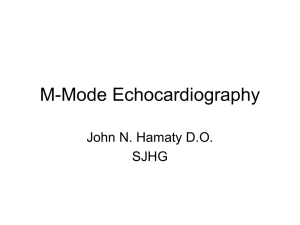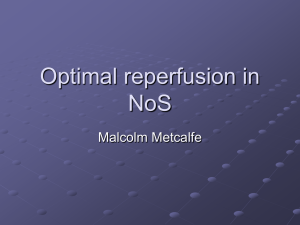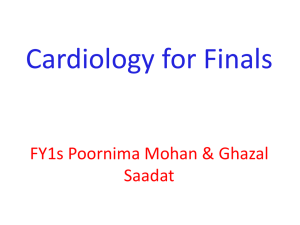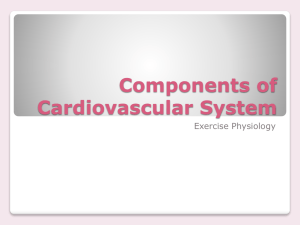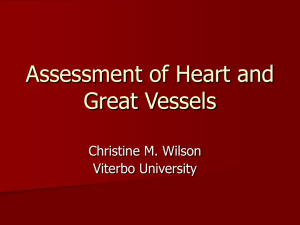HEMODYNAMICS
advertisement
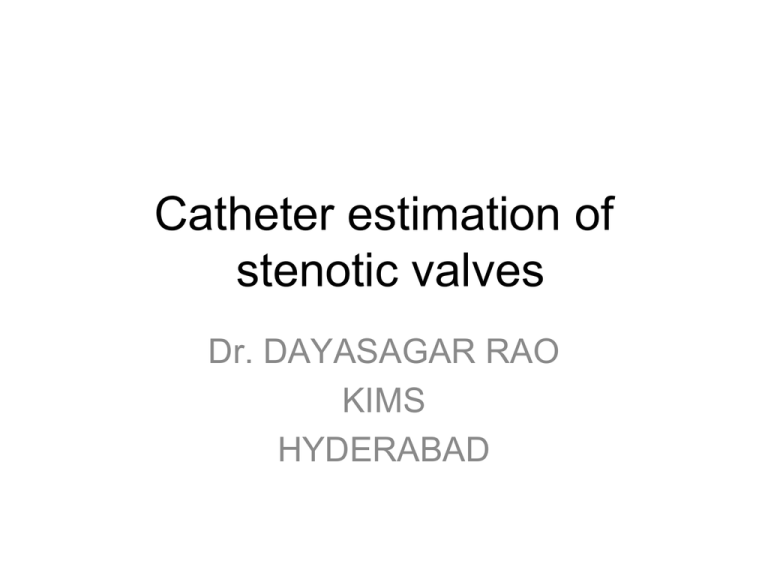
Catheter estimation of stenotic valves Dr. DAYASAGAR RAO KIMS HYDERABAD Stenotic valve orifice areaevaluation • Cardiac catheterization- gold standard? • Echo doppler • MRI based • MDCT Clinical Stenotic valve orifice areaevaluation • Is there role of catheter based assessment- stenotic valves in 2009? ACC/AHA guidelines valvular heart disease-evaluation 2008 • Discrepancy: clinical findings noninvasive data . • Technically unsatisfactory non invasive data (echo-doppler) operator dependent acoustic window TEE • Low flow- low gradient: aortic stenosis Catheter based – evaluation of stenotic orifice • Is it safe? tight/ critical stenosis cerebral embolism- calcific aortic stenosis Omran et al: LANCET 2003 152 patients aortic stenosis randomized: CAG only Vs CAG + crossing of aortic valve (retrograde) Stenotic orifice area (catheter based) • Brain MRI: diffusion imaging 22% focal diffusion imaging abnormalities 3% clinically apparent neurodeficit only in patients- crossing of aortic valve. Stenotic orifice area- catheter based • Aortic stenosis: retrograde approach antegrade Mitral stenosis: LV- PCW LV- LA Stenotic orifice area AORTIC STENOSIS- (LV-AO) METHOD EASE OF USE DISADVANTAGE PULLBACK +++++ LEAST ACCURATE FEMORAL SHEATH +++++ PRESSURE AMPLIFICATION ILIAC ARTERY STENOSIS DOUBLE ARTERIAL PUNCTURE +++ EXTRA VASCULAR ACCESS RISK PIG TAIL- DOUBLE LUMEN +++ DAMPING PIG TAIL + PRESSURE +++ EXPENSE TRANSEPTAL ++ RISK STENOTIC ORIFICE AREA • MITRAL STENOSIS • LV-PCW • LV-LA TRANSEPTAL • PROPER PCW PRESSURE: MEAN WEDGE- MEAN PA • ALIGNMENT MISMATCH- TIME DELAY 50-70 msec • REALIGNMENT- PEAK OF V WAVE BISECTED BY LV PRESSURE DOWNSTROKE. STENOTIC ORIFICE AREA MILD MODERATE SEVERE AORTIC >1.5 sq cm 1-1.5 sq cm <1 sq cm MITRAL >1.5 sq cm 1-1.5 sq cm <1 sq cm TRICUSPID <1 sq cm PULMONARY Peak gradient >60 mm hg VALVULAR STENOSISSEVERITY • Valvular disease cause of symptoms • Timing of intervention: symptomatic status natural history- symptoms Stenotic orifice area • Geometric orifice area • Effective orifice area • Critical valve area DIAGRAM SHOWING • Geometric / effective orifice area • Contraction co efficient Contraction coefficient STENOTIC ORIFICE- VALVES • Hemodynamic impact influenced by • Cross sectional area • Geometry of valve – flat valves have greater contraction co-efficient (for similar CSA and volume flow) Stenotic orifice area • Clinical implication: - Planimetry area - Effective orifice area (continuity/Gorlins) - EOA smaller than planimetered areaproportional contraction coefficient. PRESSURE RECOVERY • Fluid energy= pressure energy+ kinetic energy • Narrowed orifice (vena contracta) highest velocity • Downstream - flow stream expands • Deccleration (decreased velocity- kinetic) • Conversionkinetic – pressure (pressure recovery) PRESSURE RECOVERY Clinical implication- pressure recovery • Doppler derived gradients- using CW doppler @ vena contracta • Catheter derived gradients- downstream vena contracta- pressure recovery GRADIENT DERIVED BY CATH IS LOWER THAN DOPPLER DERIVED GRADIENT PROSTHETIC VALVES Bileaflet valves • Side orifice velocities are less than central orifice velocities. (side orifice velocities is 85% of central orifice) • Pressure recovery occurs much further downstream in central orifice than side orifice. • Discrepancy measurement of gradients- over time. Stenotic orifice area- pressure recovery • Pressure recovery is more across aortic than at mitral prosthetic valve- native valve. • Pressure recovery- exaggerated in - Smaller aorta - Stiffer aorta - Hypertension • Discrepancy between catheter derived and doppler derived pressure data. (thus calculated valve area) Stenotic orifice area- pressure recovery (exaggeration- HTN) Stenotic valve area Torricelli’s law • F= A X V A=F/V A=F/V Cc F- Flow A- Valve area V- Velocity of flow Cc- coefficient of contraction Stenotic valve area • V2 = (CV)2 X 2Gh • V= (CV) x sq root 2Gh h = pressure gradient G = gravitational constant (980 cm/sec2) for conversion cmH2 to units pressure Cv- coefficient velocity for correcting energy loss (pressure energy- kinetic energy) Stenotic valve area • A= F/V F- flow (vol flow ml/sec) • Flow rate= cardiac output/ duration of systole or diastole (SEP/DFP X HR) Stenotic valve area • Valve area= cardiac output ÷ (HR X SEP) 44.3 X C X sq root of pressure gradient C- empirical constant calculated valve area (by Gorlin) actual valve area (at surgery) Mitral Valve = constant 0.7 (later changed 0.85) Aortic valve: assumed to be 1 GORLINS FORMULA • • • • • (AHJ 1951 Gorlin R, Gorlin G) Eleven patients Right heart catheterization- PCWP Assumed LV diastolic pressure- 5mmhg Duration diastole- peripheral arterial tracing • Calculated mitral valve area • Measured MVA at surgery GORLIN FORMULA • Cardiac output • Pressure gradient across valve (mitral/aortic) • Duration of flow (DFP/SEP)- pressure tracing • Constant (calculated-measured valve area) GORLIN FORMULA Empirical constant includes Conversion of cms H2o to units of pressure • Contraction co-efficient • Velocity co-efficient • Difference- valve area calculatedand valve area at surgery GORLIN FORMULA Problems • cardiac output Fick - oxygen consumption Thermodilution- low output state - significant TR • Duration of flow (SEP-DFP) • Alignment mismatch • Calibration errors GORLIN FORMULA • Modification: HAKKI cardiac output (L/ min) Sq root of MPG • Heart rate: 60- 100/ min Stenotic valve orifie area • Catheterization : gold standard ? (Grossman et al 2006) 1.Invasive procedure 2.Risk 3.Limitations – measured parameters - calibration -valvular regurgitation 4.Expensive ACC/AHA Guidelines


